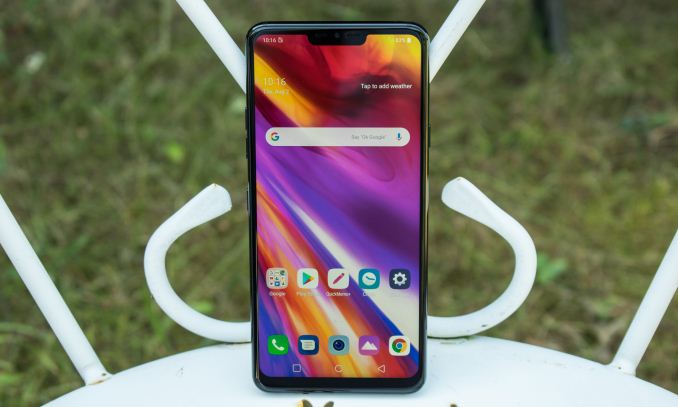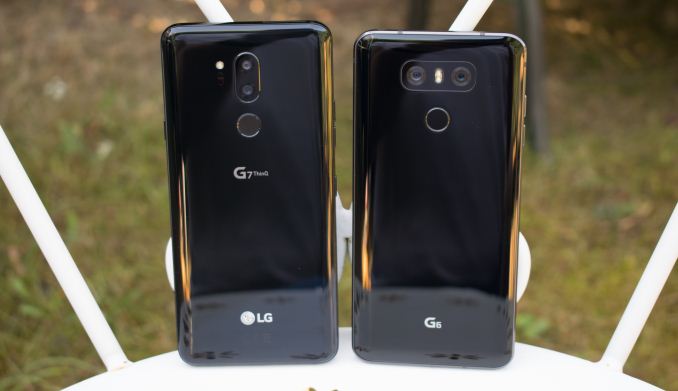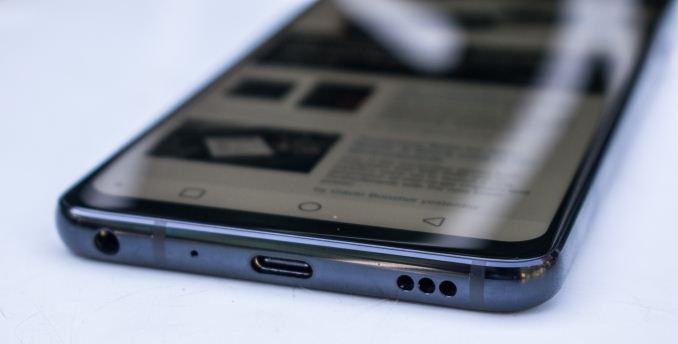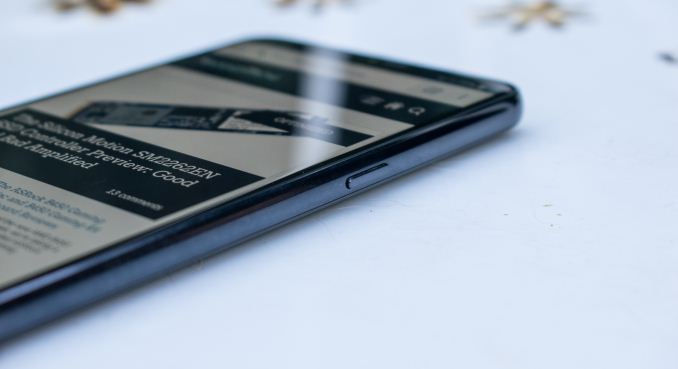The LG G7 Review: A Rushed Attempt?
by Andrei Frumusanu on August 9, 2018 11:00 AM EST- Posted in
- Smartphones
- LG
- Mobile
- LG G7 ThinQ
- LG G7

This year was a change in pace for LG. The company's "mainline" flagship device, the LG G7, was released a couple of months later later than in years prior, hitting the market in the early summer rather than the more traditional spring.
And while this may sound like a trivial distinction, it's actually more meaningful than it may first appear. The tight schedules in the smartphone industry mean that time is often the most valuable asset a manufacturer can have. In this case, scheduling the G7 for a bit later in the year gave LG an opportunity to try to raise its build-quality and to offer a well-rounded smartphone, in order to produce a more viable competitor to the fierce competition that are the other flagship handsets.
The biggest impact of this shift comes in the form of the SoC – the heart of the phone. Unlike last year's LG G6, where LG opted to use a prior generation SoC, for this year, the G7 avoids such a compromise. Instead LG is packing the phone with the latest internals, and at least on paper, it looks to be a competitive offering for 2018.
LG’s been in a relatively rough spot in the last couple of years, as we’ve seen the company stumble in terms of product execution. The LG G4 suffered from performance and battery issues due the Snapdragon 808/810 issues for that generation. The G5 promised great innovation through its modular design, however this again didn’t exactly pan out in terms of commercial success, mostly due to the phone’s weaknesses such as the display as well as a compromise in build quality due to the modular design.
The G6 overall was probably LG’s most solid phone over the last few years and it didn’t have any deal-breaking issues, other than it being a S821 device in a year of S835 alternatives. 2017 has been probably the year where the V-series actually seemingly has outshined the G-series as LG’s top-tier flagship line.
The V30 has been an excellent device, however I’ve been abstaining recommendations of phone due to the fact that my review unit had really bad uniformity issues, as well as bad low-brightness picture quality on the display. Newer units we've been sampled have offered better uniformity, but both were still not quite as perfect as you'd find from Samsung alternatives. Least to say, having to play the display lottery is not something that should be happening at these price-points.
The G7 promises a lot in terms of specifications, but most importantly for LG, what the phone needs to deliver is an increase in the overall product quality as well as more attention to detail.
| LG ThinQ G7 | ||
| LG G7 | LG G6 | |
| SoC | Qualcomm Snapdragon 845 4x Kryo 385 Performance @ 2.8GHz 4x Kryo 385 Efficiency @ 1.77GHz Adreno 630 @ 710MHz |
Qualcomm Snapdragon 820 2x Kryo @ 2.34GHz 2x Kryo @ 2.19GHz Adreno 530 @ 653MHz |
| Display | 6.09-inch 3120x1440 (19.5:9) IPS LCD |
5.7-inch 2880x1440 (18:9) IPS LCD |
| Dimensions | 153.2 x 71.9 x 7.9 mm 162 grams |
148.9 x 71.9 x 7.9 mm 163 grams |
| RAM | 4GB LPDDR4x | |
| NAND | 64GB UFS 2.1 + microSD |
32/64GB UFS + microSD |
| Battery | 3000 mAh (11.55 Wh) non-replaceable |
3300 mAh (12.54 Wh) non-replaceable |
| Front Camera | 8MP medium angle (90°) | 5MP, f/2.2, wide-angle (100°) |
| Primary Rear Camera | 16MP Sony IMX351 1/3.09" 1µm pixels, narrow angle (70°) F/1.6 lens w/OIS |
13MP, Sony IMX258, narrow angle (71°) 1.12µm pixels, F/1.8 lens w/OIS |
| Secondary Rear Camera | 16MP Sony IMX351 1/3.09" 1µm pixels, wide angle (107°) F/1.9 lens |
13MP, Sony IMX258, wide-angle (125°) 1.12µm pixels, F/2.4 lens |
| SIM Size | NanoSIM | |
| Wireless | 802.11a/b/g/n/ac 2x2 MU-MIMO, BT 5.0 LE, NFC, GPS/Glonass/Galileo/BDS |
|
| Connectivity | USB Type-C, 3.5mm headset | |
| Features | Fingerprint reader, display notch, high resonancy speaker, AI assistant button, IP68 rating |
Fingerprint reader |
| Launch OS | Android 8.0 | Android 7.1 with LG UX 6.0 |
In terms of the hardware, the G7 is a large upgrade over the G6 as it represents a two-generation jump in the SoC, switching from the Snapdragon 821 to a Snapdragon 845. Performance wise we should see excellent results from the G7, as most other Snapdragon 845 devices this year have just been fantastic products.
The phone comes with 4GB of main memory as well as 64GB of UFS 2.1 storage, with the option of a microSD slot for expandable storage.
In terms of device footprint, LG actually managed to match the width and thickness of the G6 – although the industrial design has changed. The new G7 ergonomically feels like a smaller phone thanks to its more rounded edges. Where the G7 differs from the G6 in terms of dimensions is the height: it adds 4.3mm on to the top of the phone. The new format houses a longer 19.5:9 aspect-ratio screen which comes with a top display notch. Although the device is longer, its top and bottom bezels have seen a reduction compared to the G6 so the overall display-to-body ratio has increased.
A non-visible change in terms of the internals is that the battery size has actually decreased from 3300mAh down to 3000mAh – it’s possible that LG had to do this to be able to integrate the new speaker design. Overall though this doesn’t concern me too much as the efficient SoC and promised screen efficiency should still result in good battery life.
The display saw a lot of fanfare as the 3120x1440 resolution unit is of a new RGBW "M+" subpixel layout technology which promises great strides in terms of display power and power efficiency.
The back of the phone we continue to see a glass cover, and it comes with all the usually associated advantages, such as wireless charging and an IP68 rating. The camera housing has seen a redesign as the horizontal dual-camera layout in the G6 and V30 has been replaced for a smaller and tighter vertical setup.
The G7’s camera hardware hasn’t changed much from the V30’s – the main camera is still a 1/3.09" 16MP Sony IMX351 with 1µm pixels and a lens with a large f/1.6 aperture.
The wide-angle module however has seen larger changes as it sees a resolution bump from though a sensor upgrade, this time around using the same sensor as the main camera. Also notable is that the wide-angle view has been reduced from 120° down to 107° - still offering a wide angle experience but reducing the fish-eye perspective and also improving image quality by reducing chromatic aberrations on the outer portions of the image.
LG jumps on the display notch bandwagon; the official name for the G7's notch is “new second screen”. In practical terms it doesn’t differ much from what we’ve seen with other vendors. LG also offers different options to customise the area – going from various more artistic background options to the option of just blacking out the notch. For an LCD screen the G7 actually really surprised me as the display offered sufficiently high contrast ratio that blacking out the notch worked basically *almost* well as an OLED screen – however it was still visible in some bright scenarios.
On the bottom of the phone we find the speaker grill with 3 large holes. LG has made big promises on the speaker improvements as it uses the whole internal space of the phone as a resonance chamber, promising louder and better audio. Objectively measuring this was one of the reasons I’ve (re)introduced speaker evaluation into recent reviews so we’ll later in the article how LG’s efforts panned out.
There’s a USB-C port, a microphone and a 3.5mm headphone jack. LG still caters to audiophile crowd and the G7 integrates a ESS Technology ES9218P audio SoC which is stated to be able to have enough capabilities and power to drive even the most demanding high-impedance headphones with up to a 2Vrms output voltage. I measured this and unfortunately the G7 doesn't quite reach the promised levels as it is only capable of 0.764Vrms without the Quad-DAC and 1.030Vrms with the Quad-DAC enabled. Distortion wise however the G7 performed excellently - I'm working on re-building a proper audio measurement methodology for the future.
On the right side of the phone we find a lone power button. LG’s past flagships had the power button integrated on the back on the fingerprint sensor, while this was “okey” in terms of ergonomics I still think a side-power button does a better job so LG going back to the more traditional placement is a good thing in my book. The SIM and SD card tray has been now relocated to the top of the phone.
On the left side we find the volume buttons, and a brand new assistant button. Instead of creating a new custom assistant, LG fully integrates Google Now. I found the button to have a massive usability issues in terms of actually listening to commands as there’s a notable delay between pressing the button and Google Now actually starting to listen to your queries. I found this annoying enough and such a bad integration that I think it kind of defeats the purpose of the button – for contrast and as an example, Samsung’s Bixby button will instantaneously start listening to a query as soon as you press the button and the app will catch up with responding.

















69 Comments
View All Comments
djayjp - Thursday, August 9, 2018 - link
Good thing we have speaker measurements because who could possibly want NAND benchmarks? You should stop including benchmarks in SSD reviews as well.Dr. Swag - Thursday, August 9, 2018 - link
What happened to nand benchmarks? That was one of the big things I liked reading anandtech reviews for. It would also be nice if you didn't remove the display measurement comparison graphs so that we could actually compare different displays to see how they did against each other. I like the addition of speaker evaluations but that should be an addition, not a replacement...faizoff - Thursday, August 9, 2018 - link
Will the LG V30 review not be done due to the lottery display situation?Andrei Frumusanu - Thursday, August 9, 2018 - link
Phone reviews released before December 2018 were shelved as AT didn't have a mobile editor at the time before I rejoined, and it didn't make sense logistically to try to catch up with past devices when it was better to focus to be on time with the newer releases.Performance, battery, and camera evaluations of the V30 are included in all follow-up reviews from that date on.
lopri - Thursday, August 9, 2018 - link
December 2017, you mean?Andrei Frumusanu - Saturday, August 11, 2018 - link
Yes sorry, I'm a year ahead >_>eastcoast_pete - Thursday, August 9, 2018 - link
@Andrei/Anandtech: First, thanks for the review! Would it be possible to include the water-proofing as a line in the specs table in future reviews, as well as the hours of use (intensive) one gets out of a full charge. Lastly, please add a line in the conclusions on past record and promised future on OS updates of that phone maker. These three are key decision points, at least for me. I don't want to worry about getting the phone wet in a downpour, and having to take the charger with me, then look for and stay at a power outlet every few hours is really not exactly "mobile". Similarly, it's more than just annoying if a brand-new phone stays stuck two releases behind current Android versions for years or forever - I don't appreciate built-in obsolescence in $ 500+ phones.While I get the criticism of a too-blueish white balance, water-proofing (IP68, 67 or not), hours of intense use per full charge and keeping the OS current for the next 2-3 years are more important to me for a purchase decision than bluish screens, although I'd like a good white balance, too. The camera in the LG7 is a letdown, especially the video. Why still no EIS in 4K or at 1080 p60, and why not offer HEVC recording? The 845 is perfectly capable of all these. Not having those is just lazy, and not on flagship level.
Regarding the hours of use, this is another disappointing result. LG, hang your head in shame!, Don't try to make an S9+ clone; instead, make a true alternative, and dare to be different. To all phone makers: I get it, thin is hip, but a. I don't use my phone to cut vegetables with, so don't need razor-blade thinness and b. I rather take a slightly thicker and larger (longer) phone with a 4000-5000 mAh battery over a slim phone that won't make it through the day.
Andrei Frumusanu - Thursday, August 9, 2018 - link
Added in the IP68 rating - somehow I missed putting that into the table.In regards to hours of usage of a full charge. That's an inexact metric and can't and won't post subjective numbers. The battery tests are reliable, reproducible metrics that I think are still extremely good. In my usage I found the web test largely correlated with overall device runtime - of course this will differ for most users based on screen brightness and cellular connectivity.
zeeBomb - Thursday, August 9, 2018 - link
Andrei reviewing phones again? Man I'm just so disappointing it has only 3,000 mAh...CLEARLY rushed and the display is tooo blue.abufrejoval - Saturday, August 11, 2018 - link
I had the same reaction when the OnePlus 5 didn't have a bigger battery either. On my older phones I could observe the battery counting down just reading an article like this.But the 835 and 845 or I guess anything done on that 10nm FinFET LPE process feels twice as power efficient as the 14nm LPP from the 820 and it's the first time I never worry about the phone battery any more. Even after a long day, I've never dropped below 70% remaining charge and I tend to panic below 50%, just seeing 15% on review pictures makes me sweat :-)
But I'm not a smombie or a member of the look-down-clan and I guess others will want 12 hours with a non-stop screen full of Facebook action...
And then QuickCharge gives you another day within minutes.